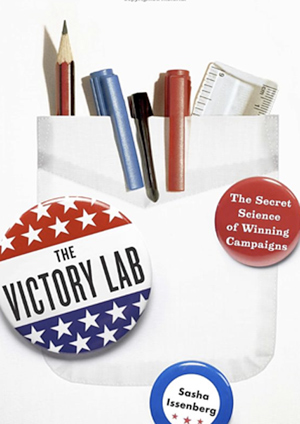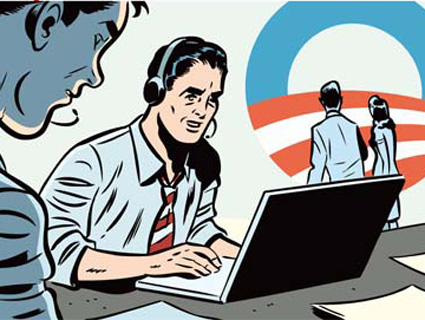 Courtesy of Crown PublishersOn a weekday morning in late September, a half-dozen reporters shuffled into the seventh-floor downtown DC offices of NARAL Pro-Choice America for a lesson in statistics. By analyzing consumer data and detailed voter files, explained political director Elizabeth Shipp, NARAL and the political research firm GQR were able to build a list of 338,000 female voters in 25 critical battleground counties who fit the profile defined as “Obama defectors”—that is, supporters of the president in 2008 who were on the fence this time around. They ran a controlled experiment to determine how NARAL’s reproductive rights message would resonate, and crunched the numbers again. In Virginia, Shipp estimated, the improved statistical model would boost Obama’s performance by an additional 8,418 votes.
Courtesy of Crown PublishersOn a weekday morning in late September, a half-dozen reporters shuffled into the seventh-floor downtown DC offices of NARAL Pro-Choice America for a lesson in statistics. By analyzing consumer data and detailed voter files, explained political director Elizabeth Shipp, NARAL and the political research firm GQR were able to build a list of 338,000 female voters in 25 critical battleground counties who fit the profile defined as “Obama defectors”—that is, supporters of the president in 2008 who were on the fence this time around. They ran a controlled experiment to determine how NARAL’s reproductive rights message would resonate, and crunched the numbers again. In Virginia, Shipp estimated, the improved statistical model would boost Obama’s performance by an additional 8,418 votes.
As recently as 2000, veteran organizers like Shipp viewed this kind of experiment as something akin to witchcraft. But as Slate reporter Sasha Issenberg explains in his new book, The Victory Lab, sophisticated modeling and targeting programs like NARAL’s are the new normal in politics. Surrogates and spin may dominate the headlines, but elections are increasingly won and lost beneath the surface by teams of academics and techies equipped with reams of data about voters and new theories on how to reach them. Issenberg spoke to Mother Jones last month about why campaigns still waste money on things that don’t work, and the biggest difference between Obama and Romney.
Mother Jones: Is data and analytics the story of the race?
Sasha Issenberg: This whole narrative takes place in the shadow of 2000. The important thing that happened after Florida was that people in campaigns started to value improvements that could get them 1 or 2 percentage points. There are a variety of reasons for that—polarization, fewer ticket-switchers, party switchers, swing voters, whatever definition you want to use—but there are far fewer persuadable voters, and so resources and attention are being focused on turnout and mobilization.
It was pretty evident all year that this was a good example of a mobilization election. By and large campaigns are realizing that the other 90 percent [who aren’t undecided] need attention too, and within that 90 percent they know who they are in a granular way, and how you engage them. People will no longer be surprised the way they might have been in 2000 if there’s a close election and it looks like something that you did that got you 1 or 2 points that made the difference. So it turned out to be sort of the perfect election to make the case that this stuff matters.
MJ: What caused you to write this?
SI: I covered politics in Philadelphia, so I paid more attention to field and voter contact stuff because in Philadelphia, operational stuff matters. In a one-party city where the divides are not obviously partisan, people who are intelligent about targeting are worth talking to. And TV’s expensive, so whether it’s mail or canvassing or getting vans to get people to the polls, there’s an attention to the mechanics, attention to things that were not just TV ads and candidate appearances—which tends to be sort of the overwhelming occupation of the national press corps.
I realized, especially after 2008, that it turned out to be under the surface a really transformative [decade] in terms of the tools that the campaigns were using, and how it changed the way they thought of where votes come from. I sort of stumbled into this subculture of researchers, academics, political operatives, who were using these tools to answer the big questions that, when I started covering politics, nobody took the trouble to ask.
MJ: There’s a long lag, after some initial research in the 1930s, in which campaigns sort of settled into a groove. Is there any sort of “aha!” moment where things began to change?
SI: Two academics at Yale want to start doing field experiments. They publish a paper in the fall of 2000—totally coincidental timing—and they end up basically auditing the political profession. They come up with these findings where it says in their experiment in New Haven that phone calls had no impact on turnout and mailers had a small impact on turnout and canvassing had a huge affect on turnout. And it comes out a few months before they have this election that basically ends in a tie. So on one end, people are sort of, “Wow we don’t laugh at 1 percent anymore!” And people in the political profession who operated with the knowledge that they could almost never be blamed for something going wrong if they told a good story about why it wasn’t their fault looked at it and saw it as sort of an audit.
So you’ve got a lot more attention from political consultants to an article published in an academic journal after that because mail vendors started using it to say: “Don’t waste your money on phones.” You start to get this awakening, on the left especially, where people are going, “Wow, these experiments are a very good way to measure things we had no way of measuring before.”
MJ: And the GOP goes in the same direction, too.
SI: Right, and the sort of realization that starts with [former Bush strategist] Matt Dowd—basically even before the Supreme Court has ruled—which is that we’re in a new paradigm of mobilization and that technique matters and that Republicans had a structural deficiency when it came to turnout.
The reelection campaign is this amazing institution in American politics, especially if you’re looking from a perspective of innovation and research. You have four years to define the set of problems, to budget and staff and schedule how you want to go about solving them. You have control of the party apparatus, which gives you local races and state parties to run tests in and trials. And you usually don’t have a primary challenger so you can build basically a four-year political operation that’s able to do R&D in a way that political consulting firms have not typically invested in and candidates and campaigns never have the resources or longevity to do.
So they have this huge research agenda that ends up doing all these tests, these 72-hour field tests, and then pioneering microtargeting in ’04, and I think we’ll look back at things the Obama campaign took on starting in November 2008 through today that sort of parallel it. These are things that no institution or anyone who wasn’t running for reelection would have ever had the ambition or reach to do.
MJ: So if Obama wins what are we going to be pointing to as the singular innovation?
SI: The Obama campaign is thinking about a different way to fuse what we know about people’s identities with their online preferences and online behaviors. The ambition of the Obama campaign to integrate all of these once siloed troves of data, which is something that—for all the stories in ’08 about how brilliant the website was and how great their online fundraising was and how great their field organizing was—people in the campaign complained day in and day out about the fact that none of that data was integrated and they were unable to leverage what they knew about someone who has given online to what they were doing in the field. So you had duplicated efforts, conflicting efforts, and there were huge structural reasons for this.
So [they’re] moving toward this idea of treating an individual simultaneously as a prospective voter, a prospective volunteer, or a prospective donor—or a volunteer a donor, whether they’ve done it or not—and leveraging the fact that at any given point a half-dozen different departments of the campaign are interacting with a citizen or are thinking about how to interact with a citizen. [They’re] allowing those departments to work in tandem, so that if somebody just gave $25 on your website your people who knock on doors don’t go around and ask if they support Barack Obama.
The value of that data ends up sort of building on itself because now you can start to run all sorts of tests and discern certain patterns that you might not otherwise. So I think that’s one big thing that they’re, it’s sort of a perpetual problem in the political community I think few people actually thought it was a solvable problem.
The other thing I wrote about for Slate is these programs they’re running which is sort of message-testing in the real world. The idea is to use these two innovations that have come about in the last decade—random profiles, and all the individual level data and modeling we have about voters—in tandem to say we’re gonna put out a message. (It’s usually done by mail or a partnered web ad.) We’ll randomly assign it to groups of people, and because we’re continuously polling across populations that come up in this micro-targeting model, we’ll see who moved. And because it’s randomized, we can attribute that move to “so-and-so got piece A about Bain,” and “so-and-so got piece B about Mitt Romney’s taxes” and “so-and-so got piece C about what he did as governor of Massachusetts.” And then, because you have hundreds of thousands of data points on each individual, you can isolate the data points on these people who have moved.
MJ: You can send these folks the Seamus mailer and these folks the Bain mailer.
SI: Yeah, and you start it in a small population and then roll it out to your whole universe but you now have this idea of who actually changes their opinion. And that’s what we care about. In focus groups, everybody has to watch an ad, or everybody has to look at the mailer that’s put in front of them. That’s why they’re being paid $75 and get the free sandwiches. You don’t look at all your mail. You don’t necessarily process every TV ad you see. This way, people aren’t aware that they’re expected to reassess their opinion on a candidate after viewing a particular message.
We’ll probably have a better sense in November of how individual findings from those tests changed Obama’s messaging tactics, but from how a campaign thinks about the problem of what do I talk about to whom and how do I talk about it, they’re doing something that’s way beyond the normal way that people in politics think about that challenge.
MJ: So up until 2000 they go about it differently. How different is what Obama doing now from what Romney’s doing?
SI: There is a significant gap—almost a generational gap—between the two parties right now, in terms of the number of people doing the most sophisticated research. I try to write about the way that one of the enduring gifts of the ’08 Obama campaign, regardless of what happens in November and afterwards, is that Obama’s charisma basically brought people into politics. You see people coming out of econometric forecasting, people who were robotics champions who had never worked on a campaign before and ended up in field offices. And because the Obama campaign was in a remarkable position in ’08 where they were always growing, always had more money, were simultaneously competing in a whole lot of states, and had tons of data, there were just a lot of smart young people who got put in front of computers and started messing around. Those people are now situated across the institutions of the left, and that does not exist in the same way on the right.
MJ: So there’s a spectrum to all of this. Obama’s on the cutting edge. Alvin Greene‘s on the other end.
SI: He’s off the spectrum.
MJ: Is this something the average campaign cares about?
SI: Very few people are running tests in campaigns, but through the Analyst Institute and through the Democratic party, the best practices from now a decade of experiments, many of them replicated different times, are widely distributed. If you are a candidate out of the box—I mean like not an out-of-the box thinker—and you’re starting a campaign from scratch somewhere in the country, your state party or legislative party has given you access. You’re not maybe doing your own research but all of a sudden the tools you have are the tools of all of this data and analytics.
The other thing is you have thousands of field officers—the 23-year-old who ran a regional field office for Obama in some state in 2008 and is now managing a congressional race is someone who has a level of familiarity with pretty sophisticated data and has come of age in a political environment where it’s really valued and there’s some accountability about it. So that ends up becoming a long-form training for the people who are now making decisions and at some point the question is when we get the turnover at the top level.
MJ: In keeping with the Moneyball-for-politics theme, is there one tactic or item or something that campaigns have always used—sort of like a pitcher’s win-loss record in baseball—that’s actually totally useless?
SI: One thing is how little the traditional messaging around “Do your civic duty,” “Your vote matters,’ all this sort of League of Women Voters stuff—how little impact that has had in test after test of getting people to change their behavior. In test after test, making voting seem dutiful and being part of this very responsible minority and “Don’t be part of the problem,” turns out not to work. That was such standard form of messaging that you would hear on the weekend before Election Day.
A lot of the big stuff is still a total mystery to us. We still have very little idea what ads do; we still have very little idea what a convention does; we still have very little idea what a vice presidential pick does; we have very little idea how broad messaging stuff affects a race. There’s tons of uncertainty about that, and the smartest people are more uncertain than the dumbest people about it.
The more you know the less confidence you should have that any of that stuff is explainable and predictable.
















